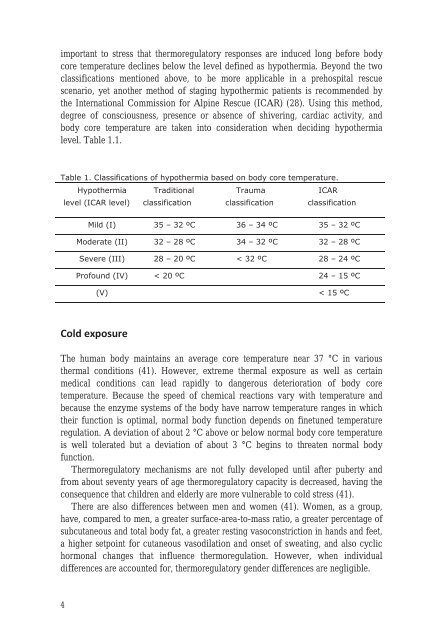Protection and treatment of hypothermia in ... - Umeå universitet
Protection and treatment of hypothermia in ... - Umeå universitet
Protection and treatment of hypothermia in ... - Umeå universitet
You also want an ePaper? Increase the reach of your titles
YUMPU automatically turns print PDFs into web optimized ePapers that Google loves.
important to stress that thermoregulatory responses are <strong>in</strong>duced long before body<br />
core temperature decl<strong>in</strong>es below the level def<strong>in</strong>ed as <strong>hypothermia</strong>. Beyond the two<br />
classifications mentioned above, to be more applicable <strong>in</strong> a prehospital rescue<br />
scenario, yet another method <strong>of</strong> stag<strong>in</strong>g hypothermic patients is recommended by<br />
the International Commission for Alp<strong>in</strong>e Rescue (ICAR) (28). Us<strong>in</strong>g this method,<br />
degree <strong>of</strong> consciousness, presence or absence <strong>of</strong> shiver<strong>in</strong>g, cardiac activity, <strong>and</strong><br />
body core temperature are taken <strong>in</strong>to consideration when decid<strong>in</strong>g <strong>hypothermia</strong><br />
level. Table 1.1.<br />
<br />
<br />
<br />
<br />
<br />
<br />
<br />
<br />
<br />
<br />
<br />
<br />
<br />
The human body ma<strong>in</strong>ta<strong>in</strong>s an average core temperature near 37 °C <strong>in</strong> various<br />
thermal conditions (41). However, extreme thermal exposure as well as certa<strong>in</strong><br />
medical conditions can lead rapidly to dangerous deterioration <strong>of</strong> body core<br />
temperature. Because the speed <strong>of</strong> chemical reactions vary with temperature <strong>and</strong><br />
because the enzyme systems <strong>of</strong> the body have narrow temperature ranges <strong>in</strong> which<br />
their function is optimal, normal body function depends on f<strong>in</strong>etuned temperature<br />
regulation. A deviation <strong>of</strong> about 2 °C above or below normal body core temperature<br />
is well tolerated but a deviation <strong>of</strong> about 3 °C beg<strong>in</strong>s to threaten normal body<br />
function.<br />
Thermoregulatory mechanisms are not fully developed until after puberty <strong>and</strong><br />
from about seventy years <strong>of</strong> age thermoregulatory capacity is decreased, hav<strong>in</strong>g the<br />
consequence that children <strong>and</strong> elderly are more vulnerable to cold stress (41).<br />
There are also differences between men <strong>and</strong> women (41). Women, as a group,<br />
have, compared to men, a greater surface-area-to-mass ratio, a greater percentage <strong>of</strong><br />
subcutaneous <strong>and</strong> total body fat, a greater rest<strong>in</strong>g vasoconstriction <strong>in</strong> h<strong>and</strong>s <strong>and</strong> feet,<br />
a higher setpo<strong>in</strong>t for cutaneous vasodilation <strong>and</strong> onset <strong>of</strong> sweat<strong>in</strong>g, <strong>and</strong> also cyclic<br />
hormonal changes that <strong>in</strong>fluence thermoregulation. However, when <strong>in</strong>dividual<br />
differences are accounted for, thermoregulatory gender differences are negligible.<br />
4



